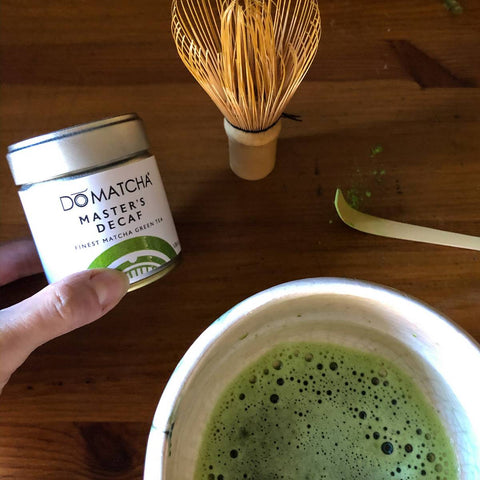One of the most notable superfoods that swept up the hearts of North Americans around a decade ago, is matcha green tea. Traditional matcha originates from ancient Japan and is produced through a laborious process of stone grinding of tea leaves, leaving behind a fine, delicate green powder. This matcha powder is extremely potent in antioxidants and an amino acid called L-theanine. For those who are trying to reduce their caffeine consumption, decaf green tea provides a wonderful alternative. The only tea brand that carries decaf Japanese matcha green tea is DoMatcha.
How is Decaf Japanese Green Tea Made?
DoMatcha produces all their matcha products in collaboration with a 16th generation tea master in Japan and one of the oldest and most reputable Japanese tea producers. The green tea leaves used in the decaf Japanese green tea are 100% Tencha leaves, and never Sencha. Tencha simply refers to the process of shading young tea leaves for a period of time (usually 2-4 weeks) and destemming before grinding to increase the sweetness of the overall matcha powder. The decaffeination process is proprietary to Domatcha, taking approximately four years to develop, involving only liquid CO2 and water, leaving behind a matcha powder that contains minimal traces (~6mg) of caffeine but preserves all the health benefits.
Drink Timing: Low Caffeine Matcha
Regular matcha generally shouldn’t warrant a jittery effect, compared to its caffeine heavy counterpart, coffee. However, for individuals who are extremely caffeine sensitive, it’s generally safer to refrain from any type of food product containing caffeine. Fortunately, DoMatcha carries a premium Master’s Decaf Matcha that contains minimal traces of caffeine and is suitable for before bedtime consumption. This is the only matcha product that is recommended to be consumed in the evening because of its low caffeine content. A study found that middle aged individuals who consumed low caffeine green tea experienced lower stress levels and improved sleep quality than those who consumed regular green tea.
How to Get the Maximum Matcha Tea Benefits
“One cup of matcha a day keeps the doctors away.” Unlike coffee, you can consume matcha several times a day without negative effects (such as headaches, jitteriness, anxiety, dehydration). Matcha is incredibly alkalizing in the gut, as well, may act like a prebiotic to speed up detoxification processes in the colon.
Matcha has also been shown to have stabilizing effects on blood sugar levels, which may help with managing cravings, weight maintenance and weight loss.3 It’s frequently touted as a beautifying or anti-aging food because of its remarkable antioxidant content. In fact, 30% of the dry mass of matcha is comprised of flavonols, flavandiols and phenolic acids.4
To get the maximum benefits from matcha green tea, make sure you choose the highest quality selection. Where tea leaves are sourced and how they’re processed has recognizable contributions to its bioavailability and flavour profile. Regions like Uji, Kyoto and Kagoshima are reputable for yielding a consistent, high-quality production of green tea leaves. A notable sign to tell whether your matcha is good quality or not is simply by the colour. Premium matcha powder should never be a dull or army green; it’s remarkable by its vibrant green shade, an indicator that it’s produced from whole tea leaves (no stems) and richness in chlorophyll and antioxidants.
Conclusion
Matcha is a powerful food that can be consumed by everyone; even those with caffeine sensitivity. With decaf matcha green tea, one can harness the health benefits of matcha without worrying about over-stimulation. DoMatcha has carefully considered the needs of their customers and formulated the first decaf matcha, with the same premium quality and tradition that permeates throughout the entire brand.

